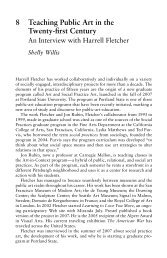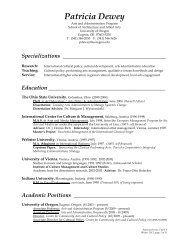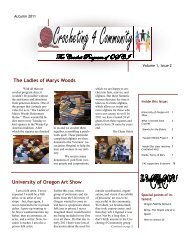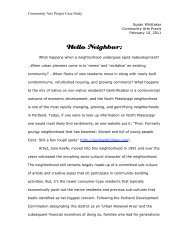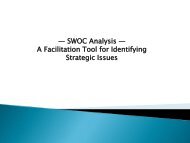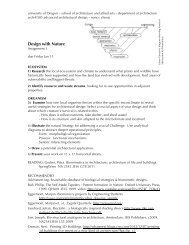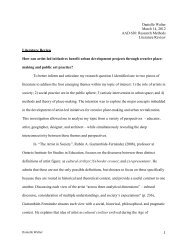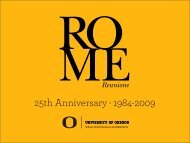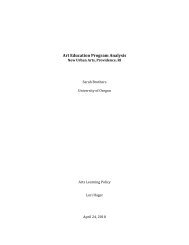Cultures of sustainability and the aesthetics of the pattern that ...
Cultures of sustainability and the aesthetics of the pattern that ...
Cultures of sustainability and the aesthetics of the pattern that ...
Create successful ePaper yourself
Turn your PDF publications into a flip-book with our unique Google optimized e-Paper software.
<strong>Cultures</strong> <strong>of</strong> <strong>sustainability</strong> <strong>and</strong> <strong>the</strong> aes<strong>the</strong>tics <strong>of</strong> <strong>the</strong> <strong>pattern</strong><br />
<strong>that</strong> connects<br />
Sacha Kagan 1<br />
Leuphana Universität Lüneburg (Germany)<br />
Abstract<br />
Contemporary developments around <strong>the</strong> search for '<strong>sustainability</strong>' <strong>of</strong>fer an<br />
insightful approach to <strong>the</strong> question <strong>of</strong> an emerging global mindset change. In<br />
its cultural dimension, <strong>the</strong> search process for <strong>sustainability</strong> fosters a<br />
paradigmatic shift in world views <strong>and</strong> ways <strong>of</strong> life, breeding a sensibility to <strong>the</strong><br />
“<strong>pattern</strong> <strong>that</strong> connects” (as coined by Gregory Bateson).<br />
1. Sustainability <strong>and</strong> culture<br />
1.1 Sustainability<br />
Sustainability is most <strong>of</strong>ten described as <strong>the</strong> triptych <strong>of</strong> social justice,<br />
ecological integrity <strong>and</strong> economic well-being [1]. However, one may prefer an<br />
alternative interpretation pointing at <strong>the</strong> triptych <strong>of</strong> biodiversity, cultural<br />
diversity <strong>and</strong> human well-being.<br />
One <strong>of</strong> <strong>the</strong> fundamentally innovative characteristics <strong>of</strong> <strong>the</strong> concept <strong>of</strong><br />
<strong>sustainability</strong> is <strong>that</strong> it calls forward a whole range <strong>of</strong> apparently paradoxical<br />
reconciliations: reconciliation <strong>of</strong> normative <strong>and</strong> so-far supposedly ‘positive’<br />
science, reconciliation <strong>of</strong> <strong>the</strong> economy with <strong>the</strong> ecology, reconciliation <strong>of</strong><br />
matter <strong>and</strong> culture (i.e. society, technology <strong>and</strong> environment), <strong>and</strong><br />
reconciliation <strong>of</strong> intra-generational <strong>and</strong> intergenerational justices (i.e. <strong>the</strong> needs<br />
<strong>of</strong> present generations across <strong>the</strong> planet <strong>and</strong> <strong>the</strong> needs <strong>of</strong> future generations).<br />
Sustainability is a young concept for an age <strong>of</strong> hypercomplexity, where<br />
challenges <strong>of</strong> increasingly globalizing economic exchanges as well as cultural<br />
exchanges are combining with <strong>the</strong> challenge <strong>of</strong> interconnected global <strong>and</strong> local<br />
ecological <strong>and</strong> social crises. Confronting this complexity implies an approach <strong>of</strong><br />
systems, i.e. anthropo-systems within ecosystems, across space-scales from<br />
<strong>the</strong> local to <strong>the</strong> planetary, <strong>and</strong> across time-scales from <strong>the</strong> short to <strong>the</strong> verylong<br />
term [2, pp. 15-16], [3] <strong>and</strong> [4].<br />
1.2 A cultural change<br />
The question <strong>of</strong> a possible global mindset change emerges from <strong>the</strong><br />
challenges posed by <strong>the</strong> introduction <strong>of</strong> <strong>the</strong> search process <strong>of</strong> '<strong>sustainability</strong>' in<br />
many spheres <strong>of</strong> private <strong>and</strong> pr<strong>of</strong>essional life in recent years. Beyond <strong>the</strong><br />
current fashion in public discourses <strong>and</strong> policies across <strong>the</strong> world, abusing <strong>the</strong><br />
adjective 'sustainable' for all sorts <strong>of</strong> strategic purposes, <strong>the</strong> search for<br />
<strong>sustainability</strong> reinforces rising concerns about <strong>the</strong> civilizational path <strong>of</strong> <strong>the</strong><br />
'developed world'.<br />
1 Sacha Kagan, Research Associate, Institute for Theory <strong>and</strong> Research on Culture <strong>and</strong> <strong>the</strong> Arts (IKKK), Leuphana<br />
Universität Lüneburg, Scharnhorststr. 1D-21335 Lüneburg, Germany.
It comes as no surprise <strong>that</strong>, for example, <strong>the</strong> current president <strong>of</strong> <strong>the</strong><br />
French Republic, opportunistically recycled Edgar Morin's expression “politique<br />
de civilisation” [5] in his policy discourse in early 2008. i A diffuse feeling is<br />
emerging <strong>of</strong> a wide-scale discrepancy between, on <strong>the</strong> one h<strong>and</strong> <strong>the</strong><br />
development-path followed so far, <strong>and</strong> on <strong>the</strong> o<strong>the</strong>r h<strong>and</strong> a civilizational shift<br />
hinted at by <strong>the</strong> search for <strong>sustainability</strong>. But this feeling is most <strong>of</strong>ten not<br />
explicitly taking form. And a great deal <strong>of</strong> confusion <strong>and</strong> vagueness is<br />
maintained in <strong>the</strong> mass media about <strong>the</strong> meaning <strong>of</strong> such a civilizational<br />
change. This prolonged latency is to a large extent, to be related to <strong>the</strong> <strong>the</strong>mes<br />
dominating <strong>the</strong> mainstream discourses on 'sustainable development': Although<br />
North-South <strong>and</strong> South-South issues, social justice <strong>and</strong> gender were gradually<br />
introduced <strong>and</strong> integrated with environmental <strong>and</strong> economic priorities (at least<br />
at <strong>the</strong> level <strong>of</strong> discourses), <strong>sustainability</strong> is still most <strong>of</strong>ten considered to be<br />
based on three pillars (<strong>the</strong> economic, <strong>the</strong> social <strong>and</strong> <strong>the</strong> ecological) while<br />
change processes for <strong>sustainability</strong> are still mostly thought <strong>of</strong> in terms <strong>of</strong><br />
'green' technological innovations. ii The cultural basis for <strong>sustainability</strong> has been<br />
largely neglected, ei<strong>the</strong>r out <strong>of</strong> ignorance on <strong>the</strong> part <strong>of</strong> political, economic <strong>and</strong><br />
scientific elites, or maybe because <strong>the</strong>y do realize <strong>the</strong> radical implications <strong>that</strong><br />
a cultural strategy for <strong>sustainability</strong> would have. But a growing number <strong>of</strong><br />
cultural actors have, in recent years, denounced this situation <strong>and</strong> started<br />
promoting cultural strategies for <strong>sustainability</strong> <strong>and</strong> advocating <strong>the</strong> recognition<br />
<strong>of</strong> culture as <strong>the</strong> central dimension for <strong>the</strong> search process <strong>of</strong> <strong>sustainability</strong>. One<br />
such case is <strong>the</strong> “Tutzinger Manifesto” elaborated in 2001-2002 with <strong>the</strong><br />
support <strong>of</strong> <strong>the</strong> <strong>the</strong> German 'Institute for Political Culture' [7]. At <strong>the</strong> level <strong>of</strong><br />
international organizations, UNESCO already started recognizing <strong>the</strong> pivotal<br />
role <strong>of</strong> <strong>the</strong> cultural dimension <strong>of</strong> sustainable development in <strong>the</strong> 1990's (e.g.<br />
with its action plan “The Power <strong>of</strong> Culture”) [8].<br />
The failure to consider <strong>the</strong> cultural dimension <strong>of</strong> <strong>sustainability</strong> also<br />
reveals a failure to unearth <strong>the</strong> paradigmatic value-shift, or 'global mindset<br />
change', which is required in order to construct a new “politique de civilisation”<br />
for <strong>sustainability</strong>. Indeed, <strong>the</strong> search process <strong>of</strong> <strong>sustainability</strong> is first <strong>and</strong><br />
foremost, to be understood as a search for 'cultures <strong>of</strong> <strong>sustainability</strong>'. iii<br />
In <strong>the</strong> following pages, I will elaborate on this search for 'cultures <strong>of</strong><br />
<strong>sustainability</strong>', following-up on a recent publication introducing this field <strong>of</strong><br />
inquiry [9]. iv<br />
2. Keywords for cultures <strong>of</strong> <strong>sustainability</strong><br />
No rigid or fixed definition <strong>of</strong> 'cultures <strong>of</strong> <strong>sustainability</strong>' can be elaborated.<br />
Indeed, a fixed definition would move against some <strong>of</strong> <strong>the</strong> basic principles <strong>of</strong><br />
cultures <strong>of</strong> <strong>sustainability</strong> (such as its systemic character <strong>and</strong> its open identity).<br />
However, a framework for fur<strong>the</strong>r reflection can be proposed, through <strong>the</strong><br />
introduction <strong>of</strong> a number <strong>of</strong> key notions <strong>and</strong> principles:<br />
2.1 Resilience<br />
Resilience refers to <strong>the</strong> capacity to adapt to change from <strong>the</strong> “outside”.<br />
The term is used in ecology, referring to <strong>the</strong> limits <strong>of</strong> a system's capacity to be<br />
perturbed; once <strong>the</strong> limits are reached, <strong>the</strong> system ei<strong>the</strong>r collapses or finds a<br />
new state <strong>of</strong> equilibrium (Walker et al., 2006, cited in Haley [10, p. 204]). As<br />
noted by ecological artist David Haley, “<strong>the</strong> capacity to withst<strong>and</strong> disturbance<br />
2
is not just a question <strong>of</strong> how long <strong>the</strong> status quo can be maintained, but how<br />
we might evolve to dwell in this new world” [10, p. 204].<br />
Resilience necessitates <strong>the</strong> preservation <strong>of</strong> diversity: Sustainable<br />
societies can only exist as long as diversity is preserved, so <strong>that</strong> <strong>the</strong> exogenous<br />
shocks <strong>of</strong> <strong>the</strong> unexpected may give way to <strong>the</strong> endogenous responses <strong>of</strong><br />
resourceful social systems <strong>and</strong> ecosystems. Less diversity in a social <strong>and</strong>/or<br />
ecological system means a lower resilience. The cybernetic “law <strong>of</strong> requisite<br />
diversity” already delivered comparable insights half-a-century ago. In <strong>the</strong><br />
words <strong>of</strong> Joël de Rosnay:<br />
“The more complex a system, <strong>the</strong> more complex its control system must be<br />
in order to provide a "response" to <strong>the</strong> multiple disturbances produced by <strong>the</strong><br />
environment. This is <strong>the</strong> law <strong>of</strong> requisite variety proposed by Ross Ashby in<br />
1956. This very general law asserts [...] <strong>that</strong> <strong>the</strong> regulation <strong>of</strong> a system is<br />
efficient only when it depends on a system <strong>of</strong> controls as complex as <strong>the</strong><br />
system itself. In o<strong>the</strong>r words, control actions must have a variety equal to <strong>the</strong><br />
variety <strong>of</strong> <strong>the</strong> system. In ecology, for example, it is <strong>the</strong> variety <strong>of</strong> species, <strong>the</strong><br />
number <strong>of</strong> ecological niches, <strong>the</strong> abundance <strong>of</strong> interactions among species<br />
<strong>and</strong> between community <strong>and</strong> environment <strong>that</strong> guarantee <strong>the</strong> stability <strong>and</strong><br />
continuance <strong>of</strong> <strong>the</strong> community. Variety permits a wider range <strong>of</strong> response to<br />
potential forms <strong>of</strong> aggression from <strong>the</strong> environment” [11, p. 130].<br />
What does this mean, more concretely? The preservation <strong>and</strong> <strong>the</strong><br />
advancement <strong>of</strong> both biodiversity <strong>and</strong> cultural diversity are key normative<br />
targets <strong>of</strong> cultures <strong>of</strong> <strong>sustainability</strong>.<br />
But resilience shall not be understood too strictly. Our societies may also<br />
need transformations when some social-ecological systems are resilient but<br />
undesirable (e.g. for matters related to social justice). In certain situations,<br />
relative collapse may even constitute a necessary step for <strong>the</strong> construction <strong>of</strong><br />
new configurations <strong>of</strong> systems [10].<br />
2.2 The inter...<br />
Underst<strong>and</strong>ing resilience <strong>and</strong> <strong>the</strong> normative target <strong>of</strong> diversity, clears up<br />
<strong>the</strong> focus toward operational frameworks advancing cultures <strong>of</strong> <strong>sustainability</strong>.<br />
The main characteristic <strong>of</strong> such frameworks is <strong>that</strong> <strong>the</strong>y are “inter-...”, i.e. <strong>the</strong>y<br />
operate most especially at <strong>the</strong> level <strong>of</strong> <strong>the</strong> membranes, <strong>of</strong> <strong>the</strong> borders, <strong>of</strong> <strong>the</strong><br />
contact areas between different elements or different systems, <strong>and</strong> <strong>the</strong>y foster<br />
dialogues across <strong>the</strong> membranes. The “inter-...” should not be mistaken for <strong>the</strong><br />
“multi-” nor for <strong>the</strong> “integrative.” Nei<strong>the</strong>r does <strong>the</strong> “inter-...” set differences<br />
apart as irreducible, nor does it integrate differences (making <strong>the</strong>m<br />
increasingly indistinguishable).<br />
Interculturality is <strong>of</strong> course <strong>the</strong> best known example <strong>of</strong> an “inter-...”<br />
framework. Interculturality can nei<strong>the</strong>r be achieved through a multiculturalism<br />
tending to segregation (allowing each <strong>and</strong> every cultural community to get its<br />
voice heard in a distinct arena, but shaping isolated cultural areas with sharp<br />
division lines <strong>of</strong> non-interaction), nor can it be achieved through a so-called<br />
integration <strong>that</strong> imposes a hierarchy <strong>of</strong> values between a dominant national<br />
culture <strong>and</strong> cultures <strong>of</strong> minorities which are suspected <strong>and</strong> subdued. v<br />
Effective intercultural interaction requires <strong>the</strong> build-up <strong>of</strong> individual<br />
intercultural capacity: Geert H<strong>of</strong>stede [12] famously characterized three<br />
dimensions to this capacity: (1) Awareness <strong>of</strong> <strong>the</strong> relativity <strong>of</strong> one’s perceptions<br />
3
<strong>and</strong> beliefs (‘mental programming’); (2) Knowledge <strong>of</strong> o<strong>the</strong>r cultures (learning<br />
process); (3) Skills in h<strong>and</strong>ling <strong>the</strong> symbols <strong>of</strong> o<strong>the</strong>r cultures. Intercultural<br />
capacity is more than just an accumulation <strong>of</strong> information about o<strong>the</strong>r cultures;<br />
quoting T.S. Eliot: “because in <strong>the</strong> process <strong>of</strong> being affected by one powerful<br />
personality after ano<strong>the</strong>r, we cease to be dominated by anyone” [13, p. 14].<br />
This capacity thus gives <strong>the</strong> individual a richer identity <strong>and</strong> sharpens his/her<br />
critical consciousness. Besides, intercultural dialogue not only sustains cultural<br />
diversity but also builds capabilities for systems thinking, because it trains<br />
individuals <strong>and</strong> societies to think <strong>of</strong> <strong>the</strong>mselves in relationship to <strong>the</strong>ir cultural<br />
environment, instead <strong>of</strong> assimilating <strong>the</strong> environment, <strong>the</strong> alien (whe<strong>the</strong>r<br />
cultural or natural) into a closed self-referential belief system.<br />
At ano<strong>the</strong>r level (i.e. between different social groups, whe<strong>the</strong>r conceived<br />
in terms <strong>of</strong> social systems/fields or social classes, subcultures or lifestyles)<br />
inter-conventional relations <strong>of</strong>fer a framework fostering cultures <strong>of</strong><br />
<strong>sustainability</strong>: Such relations involve “entrepreneurship in conventions”, i.e. an<br />
interfacing <strong>and</strong> inter-disturbing role to be played by social agents, across social<br />
conventions <strong>and</strong> institutions. Entrepreneurship in conventions allows <strong>the</strong><br />
loosening <strong>and</strong> transformation <strong>of</strong> social conventions. It works as a trigger for<br />
change processes in social structures [14]. At <strong>the</strong> individual level, <strong>the</strong> required<br />
competence is <strong>that</strong> <strong>of</strong> a “marginal-sécant”, i.e. a social actor operating across<br />
social fields/systems [15]. An entrepreneur in conventions will also have a<br />
relatively wide “repertoire <strong>of</strong> social dispositions” [16].<br />
Interdisciplinarity also constitutes an arena for inter-conventionality<br />
through entrepreneurship conventions. However, understood in an academic<br />
sense, interdisciplinarity most <strong>of</strong>ten only represents a limited range <strong>of</strong> interconventionality.<br />
Indeed, <strong>the</strong> “inter-...” is not just a rational practice, it is also a sensibility,<br />
following Bateson's definition <strong>of</strong> aes<strong>the</strong>tics as “<strong>the</strong> sensibility to <strong>the</strong> <strong>pattern</strong><br />
<strong>that</strong> connects”, i.e. <strong>the</strong> ability to perceive connections, commonalities, shared<br />
properties between different elements <strong>of</strong> reality <strong>and</strong> different levels <strong>of</strong> reality,<br />
at different levels <strong>of</strong> abstraction [17].<br />
Following Bateson in his transdisciplinary scope <strong>and</strong> in his ethological<br />
observations, one could finally argue <strong>that</strong> <strong>the</strong> “inter-...” frameworks <strong>and</strong> related<br />
individual competences, should also include <strong>the</strong> development <strong>of</strong> inter-species<br />
communication, with <strong>the</strong> training <strong>of</strong> ethological competences among human<br />
beings. vi<br />
2.3 Systems Thinking<br />
Systems thinking is <strong>the</strong> main paradigmatic background, <strong>the</strong> substrate for<br />
thinking in terms <strong>of</strong> 'cultures <strong>of</strong> <strong>sustainability</strong>'. It also allows a qualitative leap<br />
from <strong>the</strong> “inter-...” to <strong>the</strong> “trans-...” It <strong>of</strong>fers a way to gain an overview <strong>of</strong><br />
complex systems, focusing on <strong>the</strong> relationships ra<strong>the</strong>r than on <strong>the</strong> details,<br />
following a conjunctive logic ra<strong>the</strong>r than <strong>the</strong> disjunctive logic <strong>of</strong> traditional<br />
analytical methods (Le Moigne 1990 cited in [18], pp. 105-106). The rise <strong>of</strong><br />
systems thinking after <strong>the</strong> second world war marked a shift in <strong>the</strong> history <strong>of</strong><br />
western science <strong>and</strong> inaugurated a new scientific culture <strong>that</strong> gradually gained<br />
recognition in spite <strong>of</strong> sciences' path-dependency to <strong>the</strong> old Descartes-Bacon<br />
tradition <strong>of</strong> linear-causality [11], [19] <strong>and</strong> [20].<br />
The space <strong>of</strong> this article does not allow me to do justice to such an<br />
important paradigm change, nor to properly introduce <strong>the</strong> basic<br />
epistemological elements <strong>of</strong> this alternative scientific culture. vii In short,<br />
4
systems thinking makes use <strong>of</strong> notions like “feedback loops”, “interconnected<br />
systems”, “high/low leverage points”, “different logical types” (i.e. <strong>the</strong> different<br />
logics at play at different systemic levels) <strong>and</strong> is pointing at phenomena <strong>of</strong><br />
“emergence”, “structural archetypes”, “stochastic evolutionary processes”,<br />
<strong>and</strong> <strong>of</strong> course also “resilience”. It constitutes a specific language <strong>that</strong> allows<br />
transdisciplinary work <strong>and</strong> can serve as one <strong>of</strong> <strong>the</strong> bases for cultures <strong>of</strong><br />
<strong>sustainability</strong>.<br />
The importance <strong>of</strong> logical discontinuity has to be stressed most<br />
especially, as it turns its back to a long tradition in western thought. Article 2 <strong>of</strong><br />
<strong>the</strong> “Charter <strong>of</strong> Transdisciplinarity” posits: “The recognition <strong>of</strong> <strong>the</strong> existence <strong>of</strong><br />
different levels <strong>of</strong> reality governed by different types <strong>of</strong> logic is inherent in <strong>the</strong><br />
transdisciplinary attitude. Any attempt to reduce reality to a single level<br />
governed by a single form <strong>of</strong> logic does not lie within <strong>the</strong> scope <strong>of</strong><br />
transdiciplinarity” [21].<br />
Systems thinking should not be only conceived <strong>of</strong> as a purely intellectual<br />
endeavor. A merely <strong>the</strong>oretical <strong>and</strong> abstract underst<strong>and</strong>ing <strong>of</strong> systems won't<br />
suffice to help achieve real changes in <strong>the</strong> sense <strong>of</strong> <strong>sustainability</strong>. A new culture<br />
implies new practices. It fur<strong>the</strong>r implies new habits <strong>and</strong> relevant emotions <strong>and</strong><br />
virtues. Rational discourses <strong>and</strong> recommendations alone do not suffice to carry<br />
<strong>the</strong> adhesion <strong>of</strong> individuals <strong>and</strong> groups in society, nor to foster reflexivity [22].<br />
Fur<strong>the</strong>rmore, as <strong>the</strong> research on experiential learning demonstrated, effective<br />
learning requires more than a rational, conceptual comprehension <strong>of</strong> reality: it<br />
also requires <strong>the</strong> performative apprehension <strong>of</strong> reality through tangible<br />
experiences <strong>and</strong> processed feelings [23]. “Au<strong>the</strong>ntic education cannot value<br />
abstraction over o<strong>the</strong>r forms <strong>of</strong> knowledge. It must teach contextual, concrete<br />
<strong>and</strong> global approaches. Transdisciplinary education revalues <strong>the</strong> role <strong>of</strong><br />
intuition, imagination, sensibility <strong>and</strong> <strong>the</strong> body in <strong>the</strong> transmission <strong>of</strong><br />
knowledge” [21, article 11].<br />
One especially insightful illustration <strong>of</strong> this more-than-rational application<br />
<strong>of</strong> systems thinking can be found in <strong>the</strong> "Systems Thinking Games" elaborated<br />
by Linda Booth Sweeney <strong>and</strong> Dennis Meadows [24]. These games allow players<br />
to comprehend <strong>and</strong> apprehend both <strong>the</strong> working <strong>of</strong> human beings individually<br />
<strong>and</strong> in groups (with <strong>the</strong>ir mental models, habits <strong>and</strong> conventions), <strong>and</strong> <strong>the</strong><br />
working <strong>of</strong> systems (with <strong>the</strong>ir feedback loops, interdependencies, leverage<br />
points, time delays, short-term vs. long-term loops <strong>and</strong> <strong>the</strong> structural<br />
archetypes <strong>of</strong> different systems). The games also train each player's intuition<br />
<strong>and</strong> creativity when confronted with complex systems, i.e. lateral, syn<strong>the</strong>tic<br />
thinking (<strong>and</strong> not only analytical, logical thinking).<br />
2.4 Autoecopoiesis<br />
With his wide-ranging <strong>the</strong>ory <strong>of</strong> <strong>the</strong> differentiation <strong>of</strong> modern society as a<br />
pr<strong>of</strong>ound segmentation into mutually opaque social systems, systems <strong>the</strong>orist<br />
Niklas Luhmann elaborated an especially strong indictment <strong>of</strong> modernity as a<br />
culture <strong>of</strong> un<strong>sustainability</strong>. The overall social system, in contemporary society,<br />
is incapable <strong>of</strong> communicating directly with <strong>the</strong> non-human environment. It can<br />
only be 'irritated' by its direct environment. For Luhmann, <strong>the</strong> human being<br />
him- or herself i.e. <strong>the</strong> psychic system, <strong>and</strong> <strong>the</strong> social system, are<br />
environments to one ano<strong>the</strong>r, <strong>and</strong> <strong>the</strong>y do not communicate directly; but <strong>the</strong>y<br />
can be 'structurally coupled' <strong>and</strong> may 'irritate' each o<strong>the</strong>r. An autopoietic<br />
system is able to select which irritations it will notice <strong>and</strong> ignore <strong>the</strong> o<strong>the</strong>r ones.<br />
As long as <strong>the</strong> systems are only “autopoietic”, nothing guarantees <strong>that</strong><br />
5
<strong>the</strong>y will genuinely evolve, acting upon irritations. They are more likely to<br />
interpret <strong>the</strong> irritations in ways <strong>that</strong> will eventually lead to <strong>the</strong>ir self-annihilation<br />
through fur<strong>the</strong>r mis-consideration <strong>of</strong> <strong>the</strong> environment. Luhmann's conclusions<br />
on <strong>the</strong> possibility for social systems to overcome <strong>the</strong> contemporary ecological<br />
crisis are especially pessimistic [25].<br />
However, a deviation from Luhmann's conception is necessary in order to<br />
envisage cultures <strong>of</strong> <strong>sustainability</strong>. Strict autopoiesis as a culture <strong>of</strong><br />
un<strong>sustainability</strong> in hypermodernity, is not an inescapable trend. Autopoiesis is<br />
but only a tendency <strong>that</strong>, if strong <strong>and</strong> dominant so far, may be balanced by<br />
ecopoietic tendencies, i.e. tendencies <strong>of</strong> psychic systems <strong>and</strong> social systems to<br />
construct <strong>the</strong>mselves in open communications with <strong>the</strong>ir environments<br />
(implying a co-determination <strong>and</strong> co-evolution <strong>of</strong> both <strong>the</strong> system <strong>and</strong> its<br />
environment through <strong>the</strong> emergence <strong>of</strong> properties stemming from <strong>the</strong> open<br />
communication between system <strong>and</strong> environment). Actually, <strong>the</strong> proper term<br />
for this co-evolutionary process is autoecopoiesis. viii Not only 'eco-' is<br />
necessary, but also 'auto-' because <strong>the</strong> capacity for relative autonomy (i.e. a<br />
capacity for self-closure) is a pre-requisite for a system's ability to participate in<br />
its own (re-)construction.<br />
One example <strong>of</strong> such an autoecopoiesis at work between social systems<br />
<strong>and</strong> ecosystems can be found in <strong>the</strong> co-evolution <strong>of</strong> cultural diversity <strong>and</strong><br />
biodiversity. The UNESCO recently published a report raising awareness on<br />
such linkages between cultural <strong>and</strong> biological diversity <strong>and</strong> pointing to some<br />
studies from <strong>the</strong> fields <strong>of</strong> ethnobiology <strong>and</strong> ethnoecology [26]. Cultural<br />
diversity <strong>and</strong> biodiversity may co-evolve, <strong>and</strong> <strong>the</strong>reby contribute to <strong>the</strong><br />
resilience <strong>of</strong> human societies.<br />
2.5 Coevolutions<br />
As already evoked in <strong>the</strong> above paragraph on autoecopoiesis, cultures <strong>of</strong><br />
<strong>sustainability</strong> are characterized, not only by evolution, but more especially by<br />
coevolutions. “Each party in a coevolutionary relationship exerts selective<br />
pressures on <strong>the</strong> o<strong>the</strong>r, <strong>the</strong>reby affecting each o<strong>the</strong>rs' evolution” [27]. In an<br />
age <strong>of</strong> hypercomplexity inextricably interweaving social systems <strong>and</strong><br />
ecosystems for better or worse, interdependencies increase <strong>the</strong> relevance <strong>of</strong><br />
coevolutionary capacities. Resilience, as mentioned above, also benefits from<br />
coevolution.<br />
The concept <strong>of</strong> evolution used here should not be mistaken for a so-called<br />
“evolutionist” discourse. As Bateson clearly articulated, evolutionary processes<br />
<strong>and</strong> <strong>the</strong>ir selective mechanisms play a role at <strong>the</strong> levels <strong>of</strong> populations <strong>and</strong> not<br />
at <strong>the</strong> level <strong>of</strong> individual units, i.e. <strong>the</strong> concept only makes sense as a systemic<br />
concept, at certain levels <strong>of</strong> emergence. Many misunderst<strong>and</strong>ings <strong>and</strong><br />
misleading uses <strong>of</strong> <strong>the</strong> concept <strong>of</strong> evolution come from “errors in logical<br />
typing”, as Bateson argued, i.e. mistaking <strong>the</strong> causal mechanisms at <strong>the</strong> level<br />
<strong>of</strong> individual beings with <strong>the</strong> causal mechanisms operating at <strong>the</strong> more general<br />
levels <strong>of</strong> populations [17]. Bateson described evolution as a “stochastic<br />
process” whereby r<strong>and</strong>om change/mutations are met with arbitrary selective<br />
mechanisms at <strong>the</strong> level <strong>of</strong> populations. The process <strong>of</strong> evolution as described<br />
by Bateson confirms <strong>the</strong> necessity <strong>of</strong> maintaining or increasing diversity in<br />
order to maintain or enhance resilience.<br />
The concept <strong>of</strong> evolution used here st<strong>and</strong>s in explicit contrast to<br />
Luhmann's conception <strong>of</strong> <strong>the</strong> evolution <strong>of</strong> social systems. The description by<br />
Luhmann <strong>of</strong> what he analyses as <strong>the</strong> evolution <strong>of</strong> social systems, is actually, a<br />
6
perfect description <strong>of</strong> 'development', i.e. a mechanism <strong>of</strong> which modernity is<br />
<strong>the</strong> keystone: For Luhmann, evolution is not <strong>the</strong> history <strong>of</strong> <strong>the</strong> adaptation <strong>of</strong><br />
society to its environment: “Not only does <strong>the</strong> system not adapt to its<br />
environment, but it chooses or alters its environment to adapt it to what <strong>the</strong><br />
system itself prefers” [28, p. 552]. In an autopoietic system, <strong>the</strong> next operation<br />
is more important than taking <strong>the</strong> future into account. The social system is <strong>the</strong>n<br />
doomed to its eventual collapse through <strong>the</strong> ecological crisis [25, p. 38].<br />
On <strong>the</strong> contrary, <strong>the</strong> concept <strong>of</strong> evolution used here, like <strong>the</strong> concept <strong>of</strong><br />
autoecopoiesis, implies <strong>that</strong> social systems be open to <strong>the</strong>ir environments, or<br />
else lose <strong>the</strong>ir evolutionary capacity: “non-evolutionary development models<br />
try to adapt <strong>the</strong> environment to <strong>the</strong> social system while an evolutionary<br />
development adapts <strong>the</strong> social system to <strong>the</strong> environment” [29, p. 47].<br />
2.6 Open ethics<br />
The question <strong>of</strong> ethics also holds a central position in any discourse or<br />
analysis about “cultures <strong>of</strong> <strong>sustainability</strong>”. As <strong>sustainability</strong> deals with a search<br />
for good life <strong>and</strong> justice <strong>and</strong> not only elementary survival <strong>of</strong> <strong>the</strong> human species,<br />
its normative character is undeniable. However, given its fundamental<br />
valuation <strong>of</strong> cultural as well as biological diversity, <strong>sustainability</strong> cannot refer to<br />
one single “culture <strong>of</strong> <strong>sustainability</strong>” (which would be a contradiction in terms),<br />
nor does it allow any directly universal ethics. But it requires an open ethical<br />
framework, <strong>the</strong> goal <strong>of</strong> which being to preserve this very openness. Or in <strong>the</strong><br />
terms <strong>of</strong> <strong>the</strong> Charter <strong>of</strong> Transdisciplinarity: “The transdisciplinary ethic rejects<br />
any attitude <strong>that</strong> refuses dialogue <strong>and</strong> discussion” [21, article 13].<br />
The open ethics ix <strong>of</strong> cultures <strong>of</strong> <strong>sustainability</strong> are ethics <strong>of</strong> resilience, i.e.<br />
both ethics <strong>of</strong> diversity stewardship <strong>and</strong> ethics <strong>of</strong> learning capabilities. The<br />
virtues associated with such ethics are those <strong>of</strong> gamekeepers, gardeners <strong>and</strong><br />
craftspersons [30, pp. 99-100 ]. These open ethics also require <strong>that</strong> <strong>the</strong><br />
individual human being be always reflexive about his or her own perspectives<br />
on reality <strong>and</strong> about <strong>the</strong> contingencies in which he or she is embedded,<br />
following <strong>the</strong> path set by Michel de Montaigne more than four centuries ago<br />
[31].<br />
The question <strong>of</strong> ethics also relates to <strong>the</strong> question <strong>of</strong> rationality, or ra<strong>the</strong>r,<br />
rationalities, i.e. plural rationalities taking interculturality as a forum for<br />
diversity without <strong>the</strong> illusion <strong>of</strong> ever achieving a common reason through<br />
communication (in this underst<strong>and</strong>ing, <strong>the</strong> Habermassian concept <strong>of</strong> consensus<br />
through communicative action, leads to an ethical pitfall threatening<br />
<strong>sustainability</strong>) [36].<br />
In cultures <strong>of</strong> <strong>sustainability</strong>, ethics <strong>and</strong> aes<strong>the</strong>tics are inseparable. Unlike<br />
<strong>the</strong> closed ethics <strong>that</strong> constrained <strong>and</strong> hampered aes<strong>the</strong>tics throughout <strong>the</strong><br />
history <strong>of</strong> art, open ethics st<strong>and</strong> in a mutually dependent <strong>and</strong> mutually<br />
stimulative relationship with <strong>the</strong> aes<strong>the</strong>tics <strong>of</strong> <strong>pattern</strong>s <strong>that</strong> connect.<br />
3. Sustainability arts: The aes<strong>the</strong>tics <strong>of</strong> <strong>the</strong> <strong>pattern</strong>s <strong>that</strong><br />
connect<br />
Bateson claimed <strong>that</strong> aes<strong>the</strong>tics is <strong>the</strong> sensibility to <strong>the</strong> “<strong>pattern</strong> <strong>that</strong><br />
connects” [17, p. 8 <strong>and</strong> p. 118]. Morin also argued <strong>that</strong> systems thinking<br />
follows an “art principle” comparable to <strong>the</strong> “art <strong>of</strong> <strong>the</strong> skillful butcher” or to<br />
<strong>that</strong> <strong>of</strong> <strong>the</strong> musician: “The systems sensibility will be like <strong>that</strong> <strong>of</strong> <strong>the</strong> musical<br />
7
ear which perceives <strong>the</strong> competitions, symbioses, interferences, overlaps <strong>of</strong><br />
<strong>the</strong>mes in one same symphonic stream, where <strong>the</strong> brutal mind will only<br />
recognize one single <strong>the</strong>me surrounded by noise” [20, vol. 1, pp. 140-141 in<br />
1977 ed., own translation]. More specifically, I will argue <strong>that</strong> <strong>the</strong> sensibility to<br />
<strong>the</strong> <strong>pattern</strong> <strong>that</strong> connects (<strong>and</strong> sensibility to <strong>the</strong> <strong>pattern</strong>s <strong>that</strong> connect <strong>pattern</strong>s<br />
<strong>that</strong> connect) is <strong>the</strong> cornerstone <strong>of</strong> aes<strong>the</strong>tics <strong>of</strong> <strong>sustainability</strong>.<br />
But what does this characterization <strong>of</strong> aes<strong>the</strong>tics mean in practice, i.e.<br />
how can cultural practices, e.g. <strong>the</strong> arts, express <strong>and</strong> foster such a sensibility?<br />
In a broad projective way, I argued <strong>that</strong> <strong>the</strong>y can do so at three interconnected<br />
levels [2, pp. 17-19].<br />
3.1 The topics <strong>that</strong> connect<br />
A need for new approaches to knowledge stems from <strong>the</strong> search process<br />
<strong>of</strong> <strong>sustainability</strong>.<br />
“Traditional disciplinary approaches analysing individual facts or processes<br />
are no longer sufficient. Two particular challenges emerge:<br />
i) <strong>the</strong> need for integrating knowledge from various scientific disciplines <strong>and</strong><br />
ii) <strong>the</strong> necessity to produce action-oriented knowledge to cope with,<br />
mitigate, or counteract<br />
global change <strong>and</strong> its negative effects” [32].<br />
Most relevant are instances where <strong>the</strong> inter-relatedness <strong>of</strong> cultural, social,<br />
economic, political <strong>and</strong> ecological processes is explored. Also, linkages between<br />
local <strong>and</strong> global realities, between different time frames (from <strong>the</strong> short-term to<br />
<strong>the</strong> very-long term), <strong>and</strong> attention to intercultural linkages, constitute topics<br />
<strong>that</strong> connect.<br />
The sensibility to <strong>the</strong> topics <strong>that</strong> connect expresses itself most fully in<br />
transdisciplinarity, i.e. “<strong>that</strong> which is at once between <strong>the</strong> disciplines, across<br />
<strong>the</strong> different disciplines, <strong>and</strong> beyond all discipline. Its goal is <strong>the</strong> underst<strong>and</strong>ing<br />
<strong>of</strong> <strong>the</strong> present world, <strong>of</strong> which one <strong>of</strong> <strong>the</strong> imperatives is <strong>the</strong> unity <strong>of</strong><br />
knowledge.” Transdisciplinarity implies <strong>the</strong> construction <strong>of</strong> an integrative,<br />
<strong>pattern</strong>ing knowledge… “transdisciplinarity concerns <strong>the</strong> dynamics engendered<br />
by <strong>the</strong> action <strong>of</strong> several levels <strong>of</strong> Reality at once.” [33] Transdisciplinarity<br />
develops a “principle <strong>of</strong> articulation between different forms <strong>of</strong> knowledge […]<br />
which accepts <strong>that</strong> an object can pertain to different levels <strong>of</strong> reality, with<br />
attendant contradictions, paradoxes, <strong>and</strong> conflicts”[34]. This principle, as<br />
already laid out by Morin thirty years ago, implies a “dialogique” allowing<br />
“unity through diversity” or “unitas multiplex [i.e.] we cannot reduce <strong>the</strong> whole<br />
to <strong>the</strong> parts, nor <strong>the</strong> parts to <strong>the</strong> whole […] but conceive <strong>the</strong> notions <strong>of</strong> whole<br />
<strong>and</strong> parts, unity <strong>and</strong> diversity, toge<strong>the</strong>r, both as complementary <strong>and</strong><br />
antagonistic” [20, vol. 1, pp. 105 in 1977 ed., own translation].<br />
The sensibility to <strong>the</strong> topics <strong>that</strong> connect thus requires a “science <strong>and</strong> art<br />
<strong>of</strong> discovering bridges between different areas <strong>of</strong> knowledge <strong>and</strong> different<br />
beings” [34]. One’s topical “focus [shifts to] <strong>the</strong> organisation <strong>of</strong> knowledge<br />
around complex heterogeneous domains ra<strong>the</strong>r than <strong>the</strong> disciplines <strong>and</strong><br />
subjects into which knowledge is commonly organised” [35]. One <strong>of</strong> <strong>the</strong> most<br />
comprehensive approaches to topics <strong>that</strong> connect, from <strong>the</strong> world <strong>of</strong> science, is<br />
<strong>the</strong> so-called “Syndromansatz” (Syndrome Approach) invented by <strong>the</strong> German<br />
Advisory Council on Global Change (WBGU) in 1993 <strong>and</strong> fur<strong>the</strong>r developed by<br />
<strong>the</strong> Potsdam Institute for Climate Impact Research (PIK). [32], [36]. The<br />
8
approach uncovers local <strong>and</strong> global structures <strong>of</strong> unsustainable developments,<br />
identifying functional <strong>pattern</strong>s (or “clinical pictures”) <strong>of</strong> interaction between<br />
humans <strong>and</strong> nature. This approach permits to bring toge<strong>the</strong>r <strong>the</strong> insights from<br />
ecological, demographic, economic, political, cultural, technological, gender<br />
<strong>and</strong> o<strong>the</strong>r levels <strong>of</strong> reality. A syndrome’s systemic network <strong>of</strong> interrelationships<br />
can best be modeled graphically, as a networked table with typically 9 spheres<br />
represented: Pedosphere, Atmosphere, Hydrosphere, Biosphere, Population,<br />
Economy, Social Organization (also <strong>the</strong> Polity), Psychosocial sphere (Culture)<br />
<strong>and</strong> <strong>the</strong> sphere <strong>of</strong> Science <strong>and</strong> Technology. The interest <strong>of</strong> <strong>the</strong> syndrome<br />
approach lies in focusing most especially on <strong>the</strong> linkages between phenomena<br />
<strong>of</strong> different spheres (e.g. loss <strong>of</strong> biodiversity, in <strong>the</strong> biosphere, leading to a loss<br />
<strong>of</strong> indigenous knowledge, in <strong>the</strong> sphere <strong>of</strong> science <strong>and</strong> technology) ra<strong>the</strong>r than<br />
remain limited to linkages between phenomena within one sphere or between<br />
closely related spheres (e.g. formal education <strong>and</strong> <strong>the</strong> loss <strong>of</strong> indigenous<br />
knowledge) [37]. The desired outcome is <strong>of</strong> course <strong>the</strong>n not just to perceive<br />
each such linkage by itself, but to perceive <strong>the</strong> overall syndrome as one’s focus<br />
<strong>of</strong> concern, achieving an integrated perspective.<br />
The more <strong>the</strong> focus <strong>of</strong> attention is placed on <strong>the</strong> comparisons, <strong>the</strong> interrelations,<br />
<strong>the</strong> connectedness between different dimensions or ‘levels’ <strong>of</strong> reality,<br />
<strong>the</strong> more one may speak <strong>of</strong> an aes<strong>the</strong>tics <strong>of</strong> <strong>sustainability</strong> in terms <strong>of</strong> contents.<br />
3.2 The processes <strong>that</strong> connect<br />
The processes by which cultural <strong>and</strong> artistic practices are carried out (i.e.<br />
<strong>the</strong> search processes, research processes, learning processes, working<br />
processes) are especially relevant to aes<strong>the</strong>tics <strong>of</strong> <strong>sustainability</strong>:<br />
• When <strong>the</strong>y involve all-out reflexivity about ‘ourselves’ in a wide sense<br />
(from individual routines to social institutions <strong>and</strong> polities);<br />
• When reflexivity skills <strong>of</strong> different types are developed, appealing to a<br />
diversity <strong>of</strong> human qualities, beyond <strong>the</strong> limited types <strong>of</strong> rationality<br />
tapped by most scientific discourses <strong>and</strong> beyond <strong>the</strong> limitation <strong>of</strong><br />
imagination embedded in established rules <strong>and</strong> routines [22];<br />
• When interrelations are perceived <strong>and</strong> worked with, beyond <strong>the</strong><br />
fragmentation <strong>of</strong> socially constructed realities. This practically implies <strong>the</strong><br />
ability to work in inter- <strong>and</strong> transdisciplinary teams on projects. In <strong>the</strong><br />
arts especially, this implies a shift towards relatively less autonomous,<br />
less individualistic, more collaborative <strong>and</strong> more interactive working<br />
processes;<br />
• When <strong>the</strong> research, learning <strong>and</strong> working processes are also intercultural<br />
<strong>and</strong> interconventional, tapping into a human capacity for enhanced<br />
empathy, beyond sociocentrism <strong>and</strong> ethnocentrism.<br />
3.3 The values <strong>that</strong> connect<br />
Inspired by open ethics <strong>of</strong> <strong>sustainability</strong>, aes<strong>the</strong>tics <strong>of</strong> <strong>sustainability</strong><br />
inquire into <strong>the</strong> meanings <strong>and</strong> implications <strong>of</strong> justices, in a pluralistic way,<br />
opening up multiple layers <strong>of</strong> interpretations. Such aes<strong>the</strong>tics <strong>of</strong> <strong>pattern</strong>s <strong>that</strong><br />
connect, also favor participatory polyarchic polities, i.e. regimes <strong>of</strong> authority<br />
allowing experimentation with various non-hierarchical configurations <strong>of</strong> work.<br />
These political values also pr<strong>of</strong>oundly affect <strong>the</strong> criteria <strong>of</strong> aes<strong>the</strong>tic quality<br />
9
[38]. Aes<strong>the</strong>tics <strong>of</strong> <strong>sustainability</strong> also convey a humility towards <strong>the</strong> non-human<br />
environment, instead <strong>of</strong> heralding <strong>the</strong> modernist claims to be able to adapt <strong>the</strong><br />
whole environment to <strong>the</strong> dem<strong>and</strong>s <strong>of</strong> one human culture.<br />
Finally, such a sensibility sharpens critical reflexivity: critically confronting<br />
modernity <strong>and</strong> its mythical figures (e.g. <strong>the</strong> individual, progress, affluence,<br />
growth, technology); but also critically confronting one’s art world <strong>and</strong> <strong>the</strong><br />
institutions one works with as an artist or as a cultural organization (at several<br />
levels, from <strong>the</strong> informal powers behind <strong>the</strong> ‘autonomy’ <strong>of</strong> art, to <strong>the</strong> role <strong>of</strong> art<br />
as an elitist social field reproducing social distinctions <strong>and</strong> discriminations).<br />
I have deliberately not provided any specific illustrations <strong>of</strong> cultural <strong>and</strong><br />
artistic projects in <strong>the</strong> previous paragraphs, in order to keep readers'<br />
imagination <strong>and</strong> reflection open. There is probably no “perfect illustration” <strong>that</strong><br />
would demonstrate all <strong>the</strong> quintessential elements <strong>of</strong> some “ultimate”<br />
aes<strong>the</strong>tics <strong>of</strong> <strong>sustainability</strong>. Nor should <strong>the</strong>re be. The iterative, trial-<strong>and</strong>-error,<br />
experimental <strong>and</strong> experiential processes matter more than <strong>the</strong> products, in<br />
such aes<strong>the</strong>tic endeavors. And at each <strong>of</strong> <strong>the</strong> three levels I mentioned (topics,<br />
processes, values) <strong>the</strong> sensibility to <strong>the</strong> <strong>pattern</strong>s <strong>that</strong> connect can unfold itself<br />
under many different guises.<br />
The quote from T.S. Eliot (in section 2.2) continues with an exhortation to<br />
<strong>the</strong> poet <strong>that</strong> prefigures <strong>the</strong> aes<strong>the</strong>tics <strong>of</strong> <strong>the</strong> <strong>pattern</strong>s <strong>that</strong> connect: “Our<br />
civilisation comprehends great variety <strong>and</strong> complexity, playing upon a refined<br />
sensibility, it must produce various <strong>and</strong> complex results. The poet must<br />
become more <strong>and</strong> more comprehensive, more allusive, more indirect in order<br />
to force, to dislocate if necessary language into his meaning... cultivating all<br />
<strong>the</strong> possibilities <strong>of</strong> words as medium <strong>and</strong> when <strong>the</strong> speech <strong>of</strong> one sense is<br />
insufficient to convey <strong>the</strong> entire meaning (using) <strong>the</strong> languages <strong>of</strong><br />
ano<strong>the</strong>r” [13].<br />
4. A provisional conclusion: autoecopoiesis <strong>and</strong> <strong>the</strong> artful<br />
practice <strong>of</strong> cultures <strong>of</strong> <strong>sustainability</strong><br />
The emergence <strong>of</strong> cultures <strong>of</strong> <strong>sustainability</strong> <strong>and</strong> <strong>of</strong> aes<strong>the</strong>tics <strong>of</strong> <strong>pattern</strong>s<br />
<strong>that</strong> connect, opens up projective spaces for <strong>the</strong> construction <strong>of</strong> a genuine<br />
“politique de civilisation”. These spaces are not to be understood as <strong>the</strong><br />
crucible for a new unified global culture but, as argued by <strong>the</strong> philosopher Oleg<br />
Koefoed, as zones <strong>of</strong> sustension where <strong>the</strong> autoecopoietic membranes <strong>of</strong> <strong>the</strong><br />
actual <strong>and</strong> <strong>of</strong> <strong>the</strong> virtual meet <strong>and</strong> assemble intuitions <strong>of</strong> change: “The<br />
eventality is an immanent tension building an opening for virtual presents <strong>and</strong><br />
potential futures, ra<strong>the</strong>r than a transcendental force reaching from <strong>the</strong><br />
future” [39, p. 65].<br />
<strong>Cultures</strong> <strong>of</strong> <strong>sustainability</strong> may inspire hope, but <strong>the</strong>ir strength is also <strong>the</strong>ir<br />
vulnerability. As soon as <strong>the</strong>y crystallize into fixed states, closing <strong>the</strong>ir<br />
boundaries <strong>and</strong> fixing <strong>the</strong>ir borders, <strong>the</strong>y risk losing <strong>the</strong>ir elasticity <strong>and</strong><br />
porosity, down <strong>the</strong> path <strong>of</strong> autopoiesis. <strong>Cultures</strong> <strong>of</strong> <strong>sustainability</strong> are a matter <strong>of</strong><br />
constant self-critical exploration. They require a continuous re-actualization <strong>of</strong><br />
reflexive competences. For this reason, <strong>the</strong>y dem<strong>and</strong> an artful practice <strong>of</strong> life.<br />
References<br />
[1] J. Robinson, Squaring <strong>the</strong> circle? Some thoughts on <strong>the</strong> idea <strong>of</strong> sustainable<br />
development, Ecological Economics 48 (2004) pp. 369-384.<br />
10
[2] S. Kagan, Sustainability as a new frontier for <strong>the</strong> arts <strong>and</strong> cultures, in: S.<br />
Kagan , V. Kirchberg (Eds.), Sustainability: a new frontier for <strong>the</strong> arts <strong>and</strong><br />
cultures, VAS-Verlag für Akademische Schriften, Frankfurt am Main, 2008, pp.<br />
14-24.<br />
[3] E. Morin, Introduction à la pensée complexe, ESF, Paris, 1990.<br />
[4] E. Morin et al., L'an I de l'ère écologique: la Terre dépend de l'homme qui<br />
dépend de la Terre, Tall<strong>and</strong>ier, Paris, 2007.<br />
[5] E. Morin, Pour une politique de civilisation, Arléa, Paris, 2002.<br />
[6] J. Ellul, Le Système technicien, Calmann-Lévy, Paris, 1977.<br />
[7] Tutzinger Manifest. Available at: http://www.kupoge.de/ifk/tutzingermanifest/tuma_gb.html<br />
[accessed 02.12.2008].<br />
[8] UNESCO, The Power <strong>of</strong> Culture: Action Plan on Cultural Policies for<br />
Development, UNESCO, Stockholm, 1998.<br />
[9] S. Kagan , V. Kirchberg (Eds.), Sustainability: a new frontier for <strong>the</strong> arts <strong>and</strong><br />
cultures, VAS-Verlag für Akademische Schriften, Frankfurt am Main, 2008.<br />
[10] D. Haley, The Limits <strong>of</strong> Sustainability: <strong>the</strong> art <strong>of</strong> ecology, in: S. Kagan , V.<br />
Kirchberg (Eds.), Sustainability: a new frontier for <strong>the</strong> arts <strong>and</strong> cultures, VAS-<br />
Verlag für Akademische Schriften, Frankfurt am Main, 2008, pp. 194-208.<br />
[11] J. de Rosnay, Le macroscope: Vers une vision globale, Seuil, Paris, 1975.<br />
English version available at: http://pespmc1.vub.ac.be/macrbook.html<br />
[12] G. H<strong>of</strong>stede, <strong>Cultures</strong> <strong>and</strong> Organizations, s<strong>of</strong>tware <strong>of</strong> <strong>the</strong> mind:<br />
intercultural cooperation <strong>and</strong> its importance for survival, Mc-Graw-Hill<br />
International (UK) Limited, London, 1991.<br />
[13] E. Drew, T.S. Eliot: The Design <strong>of</strong> His Poetry, Indradoaba House, Delhi,<br />
1970.<br />
[14] S. Kagan, Art Effectuating Social Change: double entrepreneurship in<br />
conventions, in: S. Kagan , V. Kirchberg (Eds.), Sustainability: a new frontier for<br />
<strong>the</strong> arts <strong>and</strong> cultures, VAS-Verlag für Akademische Schriften, Frankfurt am Main,<br />
2008, pp. 147-193.<br />
[15] M. Crozier, E. Friedberg, L'acteur et le système: Les contraintes de l'action<br />
collective,Seuil, Paris, 1977.<br />
[16] B. Lahire, La culture des individus, La découverte, Paris, 2004.<br />
[17] G. Bateson, Mind <strong>and</strong> nature: a necessary unity, Hampton Press, Cresskill<br />
(NJ), 2002 [first ed. Bantam Books, 1979].<br />
[18] J.C. Lugan, La systémique sociale, 4 th ed.,Presses Universitaires de France,<br />
11
Paris, 2005.<br />
[19] G. Bateson, Steps to an ecology <strong>of</strong> mind: collected essays in anthropology,<br />
psychiatry, evolution <strong>and</strong> epistemology, Granada-Publ., London, 1978 [first ed.<br />
1973].<br />
[20] E. Morin, La méthode, Seuil, Paris, 2008 [6 volumes, first eds. from 1977 to<br />
2006].<br />
[21] L. de Freitas, E. Morin <strong>and</strong> B. Nicolescu (Eds.), Charter <strong>of</strong><br />
Transdisciplinarity, First Wold Congress <strong>of</strong> Transdisciplinarity, Convento da<br />
Arràbida, November 1994. Available at:<br />
http://nicol.club.fr/ciret/english/charten.htm<br />
[22] H. Dieleman, Sustainability, Art <strong>and</strong> Reflexivity: why artists <strong>and</strong> designers<br />
may become key change agents in <strong>sustainability</strong>, in: S. Kagan , V. Kirchberg<br />
(Eds.), Sustainability: a new frontier for <strong>the</strong> arts <strong>and</strong> cultures, VAS-Verlag für<br />
Akademische Schriften, Frankfurt am Main, 2008, pp. 108-146.<br />
[23] H. Dieleman, D. Huisingh, The potentials <strong>of</strong> games in learning <strong>and</strong> teaching<br />
about sustainable development, Journal <strong>of</strong> Cleaner Production vol. 14 no 9-11<br />
(2006), pp. 837-848.<br />
[24] L. Booth Sweeney, D. Meadows, The Systems Thinking Playbook: Exercises<br />
to stretch <strong>and</strong> build learning <strong>and</strong> Systems Thinking capabilities, Institute for<br />
policy <strong>and</strong> social science, 2001 [first. ed. 1995].<br />
[25] N. Luhmann, Ökologische Kommunikation: kann die moderne Gesellschaft<br />
sich auf ökologische Gefährdungen einstellen?, Westdeutscher Verlag, Opladen,<br />
1986.<br />
[26] A. Persic, G. Martin (Eds.), Links between biological <strong>and</strong> cultural diversity:<br />
concepts, methods <strong>and</strong> experiences, report <strong>of</strong> an international workshop,<br />
UNESCO, Paris, 2008.<br />
[27] Wikipedia contributors, Coevolution, Wikipedia, The Free Encyclopedia.<br />
Available at: http://en.wikipedia.org/w/index.php?<br />
title=Coevolution&oldid=254163710 [accessed 03.12.2008].<br />
[28] N. Luhmann, Die Wissenschaft der Gesellschaft, Suhrkamp, Frankfurt am<br />
Main, 1990.<br />
[29] D. Brocchi, The Cultural Dimension <strong>of</strong> Sustainability, in: S. Kagan , V.<br />
Kirchberg (Eds.), Sustainability: a new frontier for <strong>the</strong> arts <strong>and</strong> cultures, VAS-<br />
Verlag für Akademische Schriften, Frankfurt am Main, 2008, pp. 26-58.<br />
[30] V. Kirchberg, Angst <strong>and</strong> Un<strong>sustainability</strong> in Postmodern Times, in: S.<br />
Kagan , V. Kirchberg (Eds.), Sustainability: a new frontier for <strong>the</strong> arts <strong>and</strong><br />
cultures, VAS-Verlag für Akademische Schriften, Frankfurt am Main, 2008, pp.<br />
93-105.<br />
[31] M. de Montaigne, The Complete Essays, Penguin, London, 2003 [3 rd ed. in<br />
12
French, 1595].<br />
[32] M.K.B. Lüdecke, G. Petschel-Held <strong>and</strong> H.J. Schnellhuber, Syndromes <strong>of</strong><br />
Global Change: The First Panoramic View, Gaia 13 (2004), pp. 42-49.<br />
[33] B. Nicolescu, Manifesto <strong>of</strong> transdisciplinarity, State University <strong>of</strong> New York<br />
Press, Albany, 2002.<br />
[34] J.T. Klein, Prospects for transdisciplinarity, Futures 36 (2004), pp. 515-526.<br />
[35] R.J. Lawrence <strong>and</strong> C. Despres, Futures <strong>of</strong> transdisciplinarity, Futures 36<br />
(2004), pp. 397-405.<br />
[36] Wissenschaftlicher Beirat der Bundesregierung Globale<br />
Umweltveränderungen (German Advisory Council on Global Change, WBGU),<br />
World in Transition: The Research Challenge. Annual Report 1996, Springer-<br />
Verlag, Berlin, 1997.<br />
[37] S. Kagan, L. Pedersen, S. Ollech <strong>and</strong> D. Knaute, The Karamoja Syndrome:<br />
Transdisciplinary systems research informing policy <strong>and</strong> advocacy, 1 st World<br />
Conference <strong>of</strong> Humanitarian Studies, Groningen, February 2009. Proceedings<br />
available on CD-ROM.<br />
[38] S. Kagan, H. Abbing, Polity Conventions in Art Worlds: <strong>the</strong> constitution <strong>of</strong><br />
authority configurations, STP&A (Social Theory, Politics <strong>and</strong> Arts) 32nd annual<br />
conference, Vienna, July 2006. Available at:<br />
http://www.culture.info/images/stories/kagan_abbing.doc<br />
[39] O. Koefoed, Zones <strong>of</strong> Sustension: an exploration <strong>of</strong> eventality, culturality,<br />
<strong>and</strong> collective intuition in life <strong>and</strong> work, in: S. Kagan , V. Kirchberg (Eds.),<br />
Sustainability: a new frontier for <strong>the</strong> arts <strong>and</strong> cultures, VAS-Verlag für<br />
Akademische Schriften, Frankfurt am Main, 2008, pp. 59-92.<br />
13
i Edgar Morin is <strong>the</strong> leading French intellectual in <strong>the</strong> research on 'systems thinking' <strong>and</strong> 'sciences <strong>of</strong> complexity'. His<br />
intellectual influence is however much stronger in Central <strong>and</strong> South America than in France, where resistance is<br />
strong against his beyond-Cartesian approach.<br />
ii The critique <strong>of</strong> <strong>the</strong> “technological system” [6] which was at <strong>the</strong> heart <strong>of</strong> <strong>the</strong> development <strong>of</strong> political ecology in <strong>the</strong><br />
1970's, has been conveniently swept under <strong>the</strong> carpet by <strong>the</strong> social actors involved in <strong>the</strong> popularization <strong>of</strong><br />
'sustainable development' among <strong>the</strong>m <strong>the</strong> promoters <strong>of</strong> 'ecological modernization' as well as <strong>the</strong> new entrepreneurs<br />
<strong>of</strong> <strong>the</strong> 'green business'.<br />
iii Culture is not meant here only as a new set <strong>of</strong> (<strong>of</strong>ten superficial) lifestyles changes, nor as <strong>the</strong> restricted field <strong>of</strong><br />
'cultural practices', but also, in <strong>the</strong> anthropological sense, as <strong>the</strong> combination <strong>of</strong> values, beliefs, symbols, practices<br />
<strong>and</strong> 'scripts' or rationalities <strong>that</strong> characterize social life in a specific spatial <strong>and</strong> historical context, i.e. nothing less<br />
than <strong>the</strong> blueprint for civilizational evolution.<br />
iv The reflections presented here are benefiting from interdisciplinary collaborations, both at <strong>the</strong> “research network for<br />
<strong>the</strong> sociology <strong>of</strong> <strong>the</strong> arts” <strong>of</strong> <strong>the</strong> “European Sociological Association”, <strong>and</strong> at <strong>the</strong> international network “Cultura21”<br />
for cultures <strong>of</strong> <strong>sustainability</strong>: See www.cultura21.net <strong>and</strong> www.new-arts-frontiers.eu.<br />
v The politically correct recourse to <strong>the</strong> notion <strong>of</strong> “integration” indeed still maintains, although in a moderated form,<br />
<strong>the</strong> hierarchy <strong>of</strong> cultures which is found in its most radical form in <strong>the</strong> notion <strong>of</strong> “assimilation” (i.e. ultimately:<br />
ethnocide). While assimilation imposes a totalitarian national culture upon minorities, integration is typical <strong>of</strong> <strong>the</strong><br />
contemporary forms <strong>of</strong> “s<strong>of</strong>t totalitarianism” (<strong>the</strong> expression comes from political scientist Slobodan Milacic)<br />
enforcing <strong>the</strong> dominant culture through so-called political “consensus”.<br />
vi Following e.g. Konrad Lorenz whose pioneering work was noticed by Bateson [17].<br />
vii Although sometimes outdated, <strong>the</strong> already mentioned book by de Rosnay [11] is freely available online <strong>and</strong><br />
introduces in an accessible way <strong>the</strong> systems thinking approach.<br />
viii As far as I know, <strong>the</strong> term 'autoecopoiesis' has not been used so far. Edgar Morin used <strong>the</strong> term 'autoecoorganization'<br />
[3] which only partly covers <strong>the</strong> scope <strong>of</strong> autoecopoiesis. The elaboration <strong>of</strong> a concept <strong>of</strong> autoecopoiesis will<br />
probably also come closer to Gregory Bateson's description <strong>of</strong> systems [17] than did Luhmann's autopoiesis.<br />
ix I refrain from using <strong>the</strong> term “inter-ethics” to avoid confusions with already existing uses <strong>and</strong> abuses <strong>of</strong> this term.



